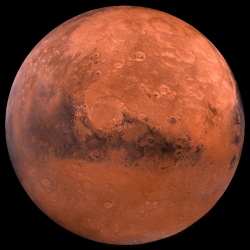
The gouge in the ground likely made by Europe’s Schiaparelli probe as it hit the surface of Mars on Wednesday has been imaged by an American satellite. The Mars Reconnaissance Orbiter (MRO) has identified a large dark patch in the robot’s targeted landing zone consistent with a high-velocity impact.
Schiaparelli is widely thought to have crashed and been destroyed. Data transmitted from the probe before it lost contact indicated that its descent systems did not work properly. Its parachute was jettisoned too early and its retrorockets, designed to slow the robot to a hover just above the surface, fired only for a few seconds. They should have operated for half a minute.
The MRO imagery is not quite definitive because the resolution is low – just six metres per pixel. Its context is persuasive, however. The roughly 15m by 40m dark patch, which is probably dust and rock fragments thrown out from the impact, is sited some 5.5km west of Schiaparelli’s expected touchdown point in the equatorial Meridiani Plain.
The European Space Agency (Esa) and MRO’s operator, the US space agency (Nasa), are confident the features described do indeed represent the scene of Schiaparelli’s contact with the surface.
Engineers continue to analyse the telemetry the probe transmitted through the various phases of its descent before dropping radio contact unexpectedly about 50 seconds before the anticipated touchdown time.
They want to establish precisely why the parachute and rocket thrusters behaved the way they did. In due course, they hope also to be able to identify the height above the surface that each event occurred.
Ultimately, the investigation should tell us at what stage in the descent sequence Schiaparelli went into freefall – somewhere between two and four km up – and the speed with which it smacked into the ground. This is estimated to be greater than 300km/h.
